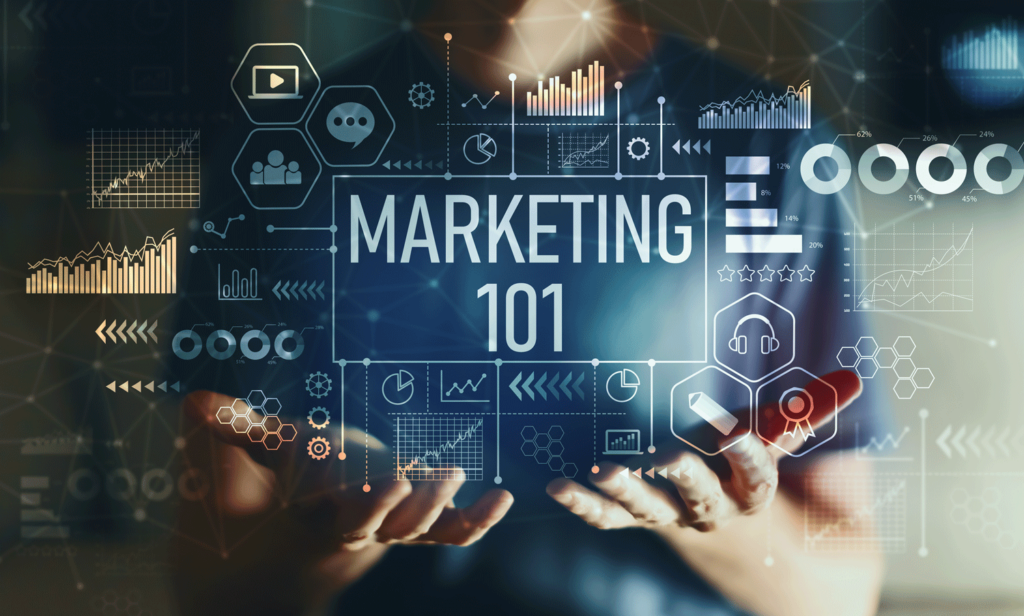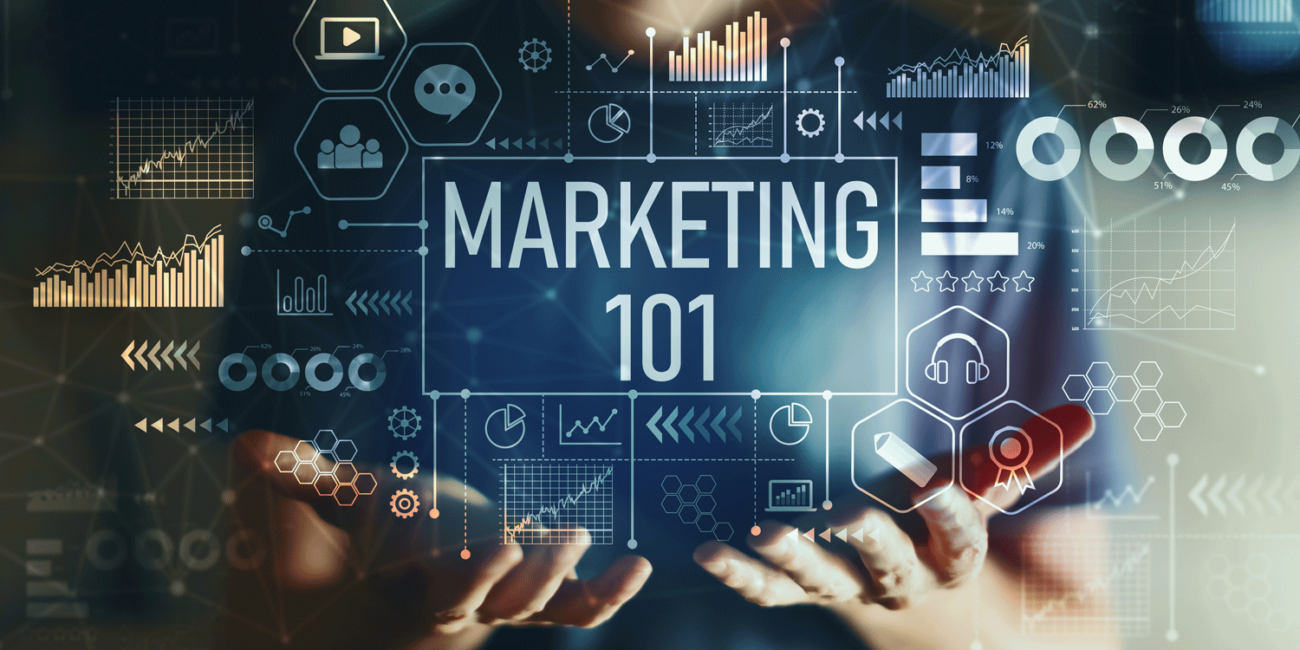The marketing landscape moves at record speed to keep pace with consumers’ evolving needs and preferences. As a result, the way marketers talk about their work—ad features and formats, targeting, performance metrics, and more—is also constantly in flux. Complex terminology, acronyms, and buzzwords dominate marketing speak, and new ones emerge regularly.
We recognize that marketing jargon can sometimes feel like a foreign language. So, we’ve pulled together a comprehensive guide to all of the industry terminology our clients may encounter in our work together.

General Terms
In this section, we highlight several key terms you may hear as we start working together, including key elements of an ad and strategy.
Landing Page
Landing pages are standalone web pages that a person “lands on” after clicking through from a digital location, such as a social media ad or email. They are often customized to a particular campaign and direct viewers to take a particular action. When done right, landing pages serve as a valuable tool for marketers to drive their audience down the marketing funnel toward conversion.
Call to Action (CTA)
A call to action is the next step an advertiser wants their target audience to take after viewing content. This is typically a conversion point, such as a download or registration. When brands encourage customers to take a specific step toward engaging with their website or content, they establish a point of contact for further communication in the future.
Bid
The highest price an advertiser is willing to pay for each click on their content. It’s often broken down as either a cost per click or cost per thousand impressions. Keeping a strong pulse on your bidding strategy and optimizing based on available metrics will ensure you get the most out of your investments.
Search Engine Results Page (SERP)
A search engine results page is the page of search engine listings that come up after a user enters a search query. For SEO, Google’s algorithm searches for web pages with keywords that closely match the query, increasing brand visibility and competitive differentiation. For paid ads, you have the ability to enter what keywords you want your ads to show for. Most brands strive to be on the first few pages for search queries that match their core product offerings.
A/B Testing
A/B testing is a methodology for comparing two versions of a strategy – ad content, audience segments, platforms, bid strategies, and more – to see which one leads to more results. It tests a control version (A) against a variant version (B) to measure the incremental difference in metrics. The results of an A/B test offer valuable insights for brands about what will most effectively achieve the brand’s campaign goals.
Advertising Solutions
In this section, we outline key advertising solutions that we offer our clients that will raise the bar on your marketing strategy for greater impact.
Search Engine Marketing (SEM)
Also known as Paid Search, SEM is a form of advertising used to increase a website’s visibility in SERPs. Keyword bids are the most common application, typically through Google Ads and Bing Ads. Search Ads typically consist of a headline, description, and URL. This strategy allows brands to ensure their content reaches the right people at the right time by targeting an audience that is already interested in the product or service they have to offer.
Pay-per-click (PPC)
Pay-per-click is the most common advertising model for SEM, where brands pay a publisher every time a user clicks on one of their ads. It’s primarily used to drive traffic to a website.
Paid Social
Paid social is a form of advertising on social media networks, targeting consumers defined by specific demographics. This allows brands to garner a wider reach and more visibility with their target audience. While social media has traditionally been known for its ability to fuel brand awareness, it has also emerged as a powerful vehicle for e-commerce.
Display
Display is a form of advertising featuring banners, text, images, video, and audio on web pages. It’s highly visual and is designed to grab consumer attention in the crowded digital landscape. It’s also targeted toward a brand’s custom audience.
Check out our recent blog on building an effective display ad campaign for more information. It delves into the value of display as a means of building brand trust and increasing conversions.
Video
Video is a form of advertising in which video ads run before, during, or after the main video a user is watching. This is most common on platforms like YouTube, where brands can target based on interests. Video has steadily grown as an advertising medium because of its unique ability to reach consumers while they are engaged in content and capture their attention in a preferred format. Video is a particularly valuable marketing medium for reaching younger generations.
Demand Gen
Demand generation is a form of advertising that drives awareness and interest in your product or service. It can include driving new business, maintaining existing business, and reclaiming lost business. A demand gen campaign typically builds and nurtures customer or prospect relationships over the long term, often targeting based on interests or purchase intent of specific products or services.

Targeting
In this section, we highlight several key terms related to targeting, which will inform how we approach reaching your audience.
Retargeting
Retargeting focuses on previous visitors to a brand’s website or app. It allows you to capture potential leads or customers who did not originally convert. Retargeting also allows you to build brand familiarity and trust over time, avoiding customer churn.
Lookalike Targeting
Lookalike targeting is the process of focusing advertising on a cohort of potential customers who share characteristics similar to your existing customers. This allows brands to reach people who are likely to be interested in your business and ultimately target higher-value and higher-quality prospects overall.
Behavioral Targeting
Behavioral targeting is the process of focusing advertising on a cohort of potential customers based on data from their browsing habits (e.g., search terms, sites visited, purchases). This information is then used to display relevant ads and offers, thereby more likely to result in a conversion. By reaching consumers where they are with the content they’re likely to be interested in, brands can develop more meaningful relationships with their target audience.
Segmentation
Segmentation is the process of dividing a brand’s target audience into groups based on demographics or behaviors. It enables personalized content for different audience segments by catering to their needs and preferences. The same content does not necessarily resonate with everyone in a brand’s target audience, so taking a segmented approach to delivery can ultimately deliver better outcomes and return on investment.
Performance Metrics
In this section, we highlight key metrics that we leverage in our work to gauge effectiveness and can also help you communicate the value of your marketing investments.
Impressions
Impressions are the number of times your ad has been displayed to a viewer, signaling the overall reach of your content. It provides insight into how well your targeting performs and whether you need to make any adjustments to get more value out of your bids.
Impression Share
Impression shares are the percentage of impressions an ad receives divided by the total number of impressions it could have gotten in the market. It offers insight into how well your ad is performing against competitors’ ads or other content in the market. Brands can glean whether or not they need to make adjustments to stand out.
Engagement Rate
Engagement rates are the percentage of people who engaged with your content divided by the total impressions for the content. It allows marketers to understand how effective their content is at pushing consumers through the funnel, whether that’s simply clicking through a social post or visiting a specified URL.
Click-through rate (CTR)
Click-through rate is the percentage of people exposed to an ad who click on a link in the content. It provides advertisers with an understanding of how effective their ads are in driving audiences to take a specific action. CTR is often used to indicate the strength of pay-per-click campaigns.
Cost per click (CPC)
Cost per click is the average cost an advertiser pays to a publisher (i.e., Google) for every click they receive on an ad. It indicates how much value advertisers are investing per action the audience takes. This insight can inform how brands make in-flight optimizations and future bids.
Cost per lead (CPL)
Cost per lead is the average cost spent to acquire a new lead. It provides visibility into how much a business pays in order to attain a conversion and offers insight into the effectiveness of lead generation campaigns. This insight allows brands to understand and maximize their budget to focus on the lowest-cost acquisition channel for their product or service.
Cost per thousand (CPM)
Cost per thousand is the average cost spent to acquire 1,000 impressions on an advertising placement. It provides visibility into how much a business spends for a higher volume of impressions, which is particularly pertinent for broad-reach campaigns. It’s most commonly used to measure Video and Display ads.
Conversion rate
Conversion rate is the percentage of website visitors who complete a desired action, such as filling out a lead form, clicking on a link, or placing an order. It offers insight into the effectiveness of moving prospects down the funnel through ad elements like CTAs. This insight is particularly valuable for brands looking to drive website traffic.
Bounce rate
Bounce rate is the percentage of users who visit a particular website and then navigate away from the site after viewing only one page. It indicates a page’s effectiveness at maintaining visitors’ attention. This insight is important because it goes beyond simply telling a brand if someone converted, but rather if they can retain the lead once they arrive at the website.
Trust J&L Marketing to Help You Navigate the Industry with Confidence
We want to empower you with the information you need to make informed decisions during our partnership. J&L Marketing has deep knowledge of the digital landscape to help you raise the bar on your marketing strategy and drive valuable conversions. Trust us to help scale your impact, outsmart your competition, and maximize the value of your investments. Contact us today.



